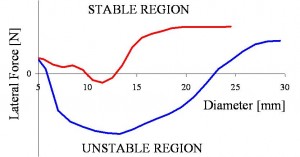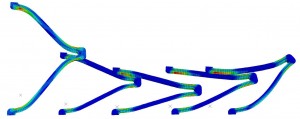 Finite Element Analysis is routinely used to evaluate the performance and durability of medical devices. When using an implicit method such as ABAQUS/Standard, FEA can also be used to evaluate the geometric stability of a proposed design. Such issues could arise for example when designing stents for large vessels, such as the aorta, when the large diameters exceed the length of the stent. When the length/diameter aspect ratio of a stent exceeds one, stability of a design could be an issue, with unstable deformation occurring causing the stent to dislodge and turn sideways in the vessel.
Finite Element Analysis is routinely used to evaluate the performance and durability of medical devices. When using an implicit method such as ABAQUS/Standard, FEA can also be used to evaluate the geometric stability of a proposed design. Such issues could arise for example when designing stents for large vessels, such as the aorta, when the large diameters exceed the length of the stent. When the length/diameter aspect ratio of a stent exceeds one, stability of a design could be an issue, with unstable deformation occurring causing the stent to dislodge and turn sideways in the vessel.
We routinely evaluate stent components for stability and occasionally are required to make suggestions for improving a component’s stability. In the plot above showing lateral force as a function of diameter, the original (in blue) and improved design (in red) demonstrate the tendency of a device to remain stable. The further into negative territory of lateral force for any given design directly correlates to a device becoming unstable. The design represented by the blue curve quickly turns into negative territory and remains there throughout most of the loading. The curve in red shows a dramatic improvement with only a portion of the loading curve becoming negative and then with only a small magnitude.
The images below illustrate buckling behavior of a stent with the image on the right becoming unstable.

